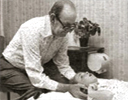 Tom Bowen | Thomas Bowen (1916-1982), an Australian, began developing Bowen therapy in the 1950s. While searching for ways to alleviate pain, he saw a relationship between certain health complaints and patterns of muscular dysfunction. He developed a technique that released blockages and stimulated the body to return to balance. He became famous for helping those for whom all other therapies had failed. |  Tom Bowen with young client |
| Tom attracted many health-care professionals interested in his technique. He invited six men to observe him, four chiropractors - Keith Davis, Nigel Love, Kevin Neave, and Romney Smeeton - an osteopath, Kevin Ryan, and a massage therapist, Oswald Rentsch. These men brought their own knowledge and understanding of the body to help them interpret what Tom was doing. All have contributed to the Bowen therapy we know today. | ||
Bowen's work did not stop with people. He also had success with animals and was well-known in Melbourne for his work with racehorses. His techniques have since been adapted for working with horses and small animals.
Niromathé therapy had its origins in India and Europe. On returning to southern France in 1920 Sister Chabrit brought back, from India, a gentle manual therapy. At the same time, Eugene Renard was practising a similar technique in the northern France he had learned from a cousin returning from the Dardanelles after World War I . The gentleness of techniques and superficial mobilization of the skin, without the use of strong manipulations such as “cracking bones,” appealed to Dr. Raymond Branly, osteopath and chiropractor, and Thierry Vandorme, an osteopath and physiotherapist, and led to the creation of a school for research and teaching now known as Niromathé therapy. This method is a revolutionary technique in the world of osteopathy and manual therapy.

